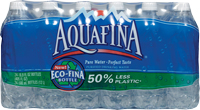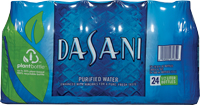By Jonathan Asher
Not long ago, a single-serve plastic water bottle suggested that a person was sophisticated and health-conscious. Today, that first impression might be more negative: a sign of waste, social irresponsibility or a lack of concern for the environment.
Although disposable bottles made of PET plastic are used for a variety of beverages, bottled water has gotten the most negative attention; most likely because tap water is seen as a readily available alternative that is more economical and environmentally friendly.
Given these concerns, bottled water manufacturers have been focused on developing more sustainable packaging and communicating these environmental benefits. But have their efforts been successful?
To find out, we recently conducted in-person interviews with 200 shoppers to understand their reactions to the environmental claims on the packaging of major bottled water brands (such as Dasani, Aquafina, Fiji, Target, Poland Spring, Deer Park, Arrowhead, Ozarka and Ice Mountain). We wanted to determine which ones they noticed (or missed), which were most compelling and whether the messages were even making a difference.

Aquafina Eco-Fina Bottle:
Many shoppers completely missed the environmental messages, though Aquafina's "Eco-Fina Bottle" claim was seen by 39 percent of shoppers-the highest finding in this study.
Many shoppers completely missed the environmental messages, though Aquafina's "Eco-Fina Bottle" claim was seen by 39 percent of shoppers-the highest finding in this study.
This low level of visibility and engagement represents a missed opportunity to improve on-pack environmental claims and, perhaps, make headway against the bottled water backlash. Manufacturers are investing significantly to develop more sustainable solutions, but they aren’t consistently reaching the shopper with this information.
When shoppers were directly asked about various claims, the findings were quite clear: the most believable, easy-to-understand and impactful claim was “100% recyclable bottle” (found on the Dasani bottle); references to reduced plastic usage, such as “50% Less Plastic” and “30% Less Plastic” were also strong. The least compelling claims were messages like “1% for the Planet” and “Eco-Shaped Bottle” which shoppers found difficult to understand.
The “Plant Bottle” claim on Dasani packaging also performed somewhat poorly, despite the considerable marketing investment parent company Coca-Cola is making to promote the partially-plant-based PET bottle. It will be interesting to see if this perception changes over time, but, regardless, this study suggests that it will be critical to link the plant bottle message more directly with its “100% recyclable” benefit.

Dasani Plant Bottle:
The most believable, easy-to-understand and impactful claim was the "100% Recyclable Bottle" message on the Dasani packaging.
The most believable, easy-to-understand and impactful claim was the "100% Recyclable Bottle" message on the Dasani packaging.
Viewed collectively, the findings from this brief study have two direct implications for bottled water marketers, or any marketers pursuing more sustainable packaging solutions:
First, keep the message simple and intuitive. Given all the environmental messaging in the market today, shoppers are understandably confused (and perhaps a bit cynical) about claims. Most are not likely to put a great deal of effort into deciphering messaging, so the clearest message is generally the most impactful.
It’s also important to make the message prominent. The environmental claims we studied appeared to be afterthoughts-last minute additions-on many packages. This not only limits visibility, but it also influences how shoppers react to the message because it implies that the claim or benefit itself is not terribly important.
If marketers want to send the message that sustainable packaging is important, they need to prioritize and emphasize it on-pack-and integrate it within the core graphic design, rather than treat it as a violator. Following these simple guidelines will help ensure that ongoing investments in environmentally-friendly packaging are not only noticed but rewarded.
Jonathan Asher is senior vice president of Perception Research Services, International (www.prsresearch.com), a company that conducts more than 800 consumer research studies annually to help marketers win at retail. Jonathan can be reached at jasher@prsresearch.com or 201.346.1600.

